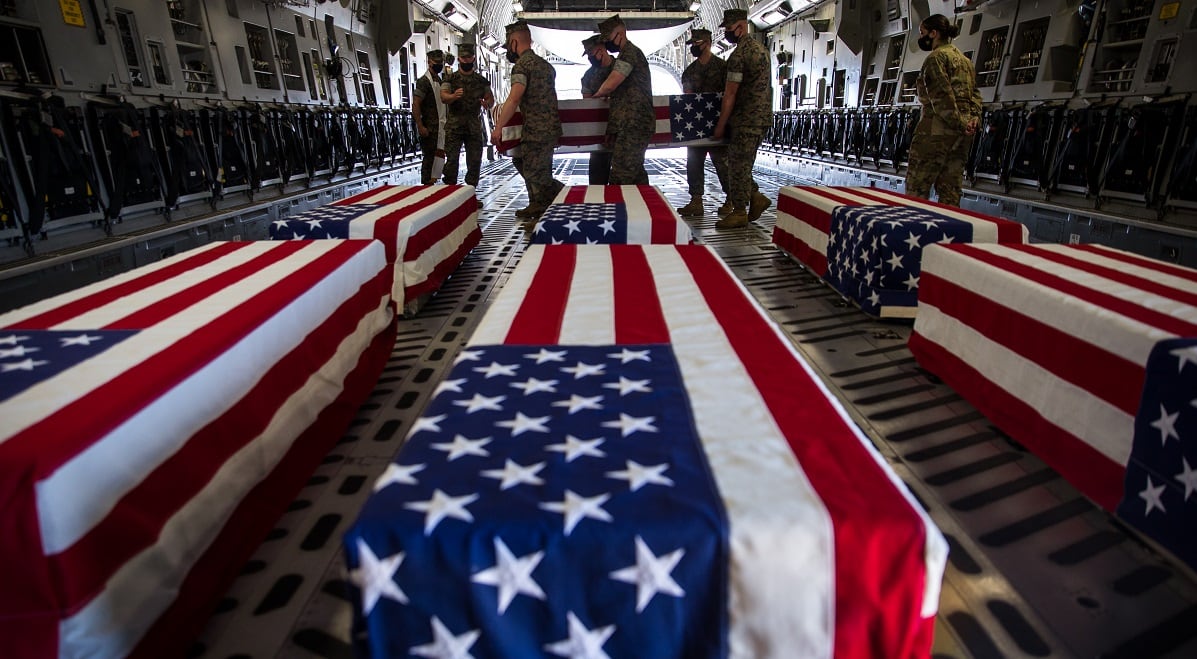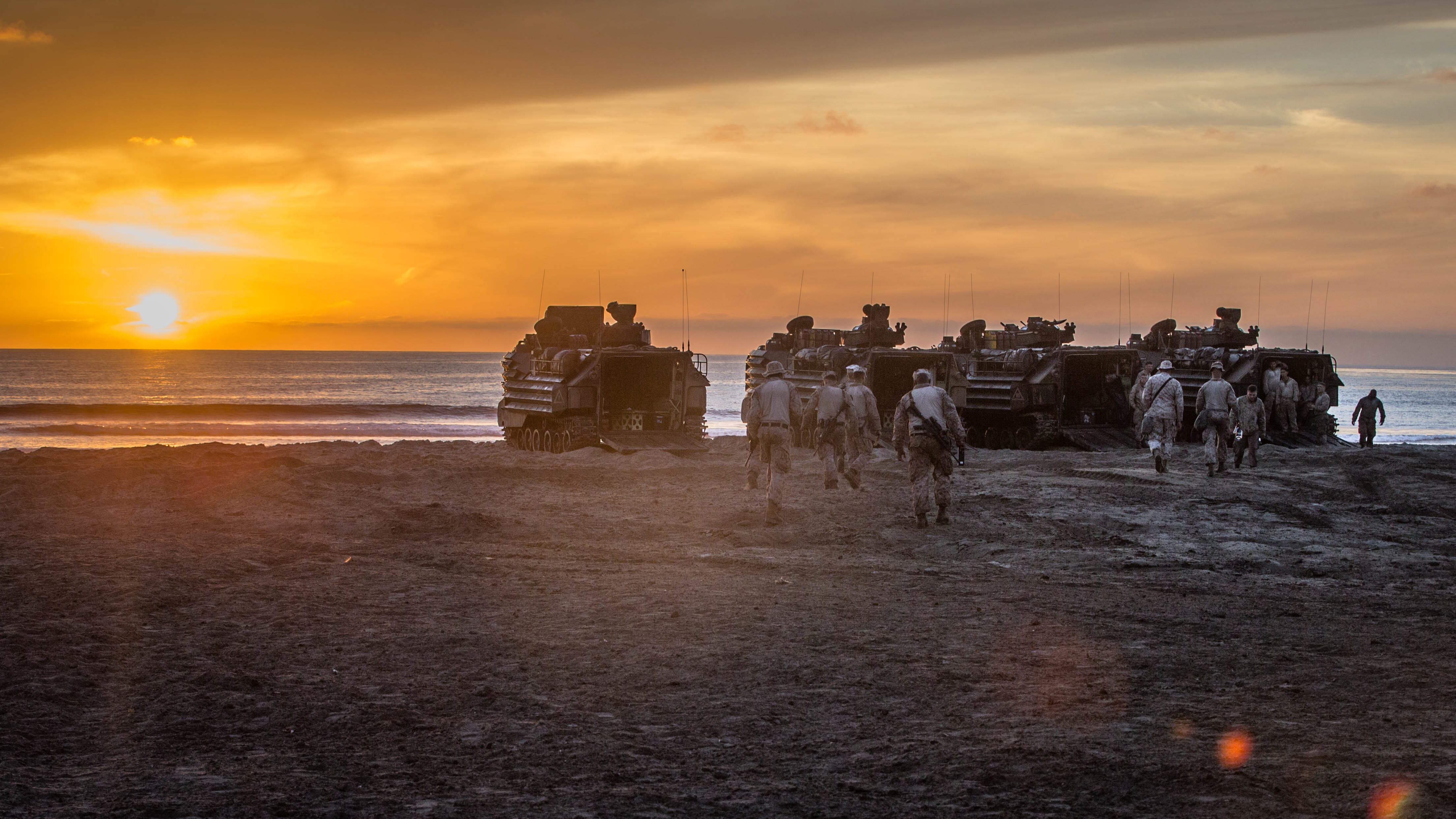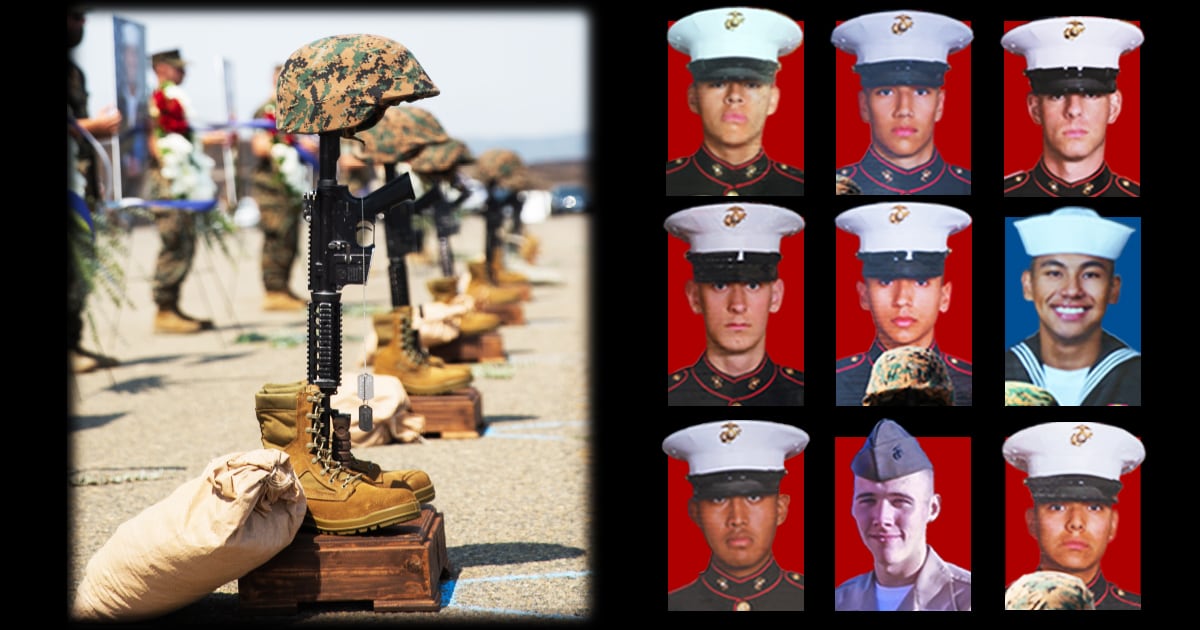“It’s alright, just calm down — we’re going to make it back to the ship. Just do me a favor and take a deep breath.”
These were the words a Marine told his amphibious assault vehicle rear crewman on July 30, 2020, as reality hit that the AAV they were in was actually sinking.
The water was up to top-of-the-boot level at that point, and the Marines and sailor trapped inside were nervous.
The platoon had been finishing a training raid and was coming from San Clemente Island, California.
Before the mission had even started that morning another AAV had been pulled for maintenance issues.
By the end of the mission four out of the 13 AAVs assigned to the 15th Marine Expeditionary Unit had broken down.
And, by the end of the day, the AAV these Marines and sailor were in would never make it back to the ship nor the shore.
Catastrophic failures led to its sinking, resulting in the deaths of eight Marines and one sailor.
Their deaths were the result of a series of failures, the 2,002 page Marine Corps investigation into the accident found.
Failures that day included the choice to use previously deadlined vehicles, the failure to notice significant mechanical issues with the AAV that sank, the failure to properly train the Marines and sailor who died, and the repeated failure to follow standard operating procedures during the exercise, the command investigation found.
RELATED

The vehicle that sank that day was 36 years old — more than 14 years older than the oldest Marine killed in the accident. They were Pfc. Bryan J. Baltierra, 18, of Corona, California, a rifleman. Lance Cpl. Marco A. Barranco, 21, of Montebello, California, a rifleman. Pfc. Evan A. Bath, 19, of Oak Creek, Wisconsin, a rifleman. U.S. Navy Hospitalman Christopher Gnem, 22, of Stockton, California, a hospital corpsman. Pfc. Jack Ryan Ostrovsky, 20, of Bend, Oregon, a rifleman. Cpl. Wesley A. Rodd, 22, of Harris, Texas, a rifleman. Lance Cpl. Chase D. Sweetwood, 18, of Portland, Oregon, a rifleman. Cpl. Cesar A. Villanueva, 21, of Riverside, California, a rifleman. And Lance Cpl. Guillermo S. Perez, 19, of New Braunfels, Texas, a rifleman.
The Marines and sailor who died were all assigned to Battalion Landing Team 1/4.
“The investigation reveals a confluence of human and mechanical failures caused the sinking … and contributed to a delayed rescue effort,” Lt. Gen. Steven Rudder, commander of Marine Forces Pacific, said in the investigation.
“Ultimately, this tragic mishap was preventable,” he said.
Mechanical problems
On the day of the incident the vehicle that sank ran into its first mechanical problem while still on the beach of San Clemente Island, California.
It was there on the beach that the AAV crew had discovered oil leaking out of the engine. They eventually added six gallons of oil to the transmission, roughly a quarter of the 23 gallons required for it to operate correctly.
“During the time we were on the island I remember ... the driver had mentioned that his transmission oil was running low,” the rear crewman in the AAV that day told investigators.
The rear crewman, whose name was redacted from the investigation, normally was an AAV mechanic, but was assigned to the AAV that day because the usual rear crewman had tested positive for COVID-19.
After refilling the vehicle with oil, the crew set off on its return trip to the Somerset, according to the investigation.
No safety boat was in the water that day.
In the morning the safety boat offered by the crew of the Somerset had mechanical issues and was unable to deploy. But, because AAVs can operate as safety boats when no other vehicle is available, the platoon commander designated one of the AAVs as the safety boat for the trip to shore. Though one AAV was designated, two were required by the standard operating procedures —one of the first violations of the day.
For the return trip the commander said he assumed the Navy would be providing safety boats and did not designate any of the vehicles as a safety boat, the investigation found.
As the AAVs headed out to sea they started to experience rougher waters than were permitted by mission’s no-go standards.
“As soon as we splashed again you knew almost immediately that the sea state was worse,” one of the Marines on the AAV told investigators. “We were rocking back and forth really hard. We were getting so much water through the hatches on top that I thought it was raining.”
Prior to any exercise, AAV leadership is supposed to observe the water to ensure Marines are not operating in unsafe conditions.
The last sea state observation that day took place around 12:23 p.m., more than four hours before the AAVs headed back to the Somerset. Though there is no definitive evidence, it is suspected that the sea state “exceeded the no-go decision criteria,” the investigation found.
Around 5:30 p.m. the rear AAV crewman in the vehicle that ended up sinking notified the vehicle commander that they were taking on water.
“Thanks for letting me know,” the commander said while continuing the trip back to the Somerset.
The water already was high enough that the Marines should have started preparing to evacuate, the investigation found.
But the vehicle commander told investigators he was not worried about the excess water because at that time the bilge pumps were working and he assumed the excess water came from waves hitting the AAV, not from any internal leak.
“There was some water in the back, which I was sure was from all the waves that we ate,” the vehicle commander told investigators.
Inspection of the vehicle after the incident found several points where water had leaked into the vehicle, including through an improperly installed headlight and the intake and exhaust plenum grills.
The investigation also found the vehicle had practically no oil in the transmission.
Shortly after taking on water the voltage in the AAV started to drop, reducing the vehicle’s radio output and preventing the bilge pumps from dumping water out of the AAV fast enough.
Eventually the transmission, low on oil, failed, triggering a chain of events that caused the vehicle to sink, the investigation found.
The transmission failure sent the engine into an idle, which caused the vehicle to stop in the water.
That loss of forward momentum prevented the forward hydraulic bilge pump from dispelling water. The rising water level in the engine led to water hitting the generator, causing the generator to fail, eventually leaving the remaining bilge pumps operating at a degraded level.
When the rear crewman told the vehicle commander that the water inside the vehicle had reached ankle level, the commander started waving the “November” flag, indicating that the vehicle was at risk of sinking. The AAV’s radio was not working.
“The next time I spoke to (the vehicle commander) was when the water was at boot top level,” the rear crewman told investigators.
“I remember screaming up to (the vehicle commander) water is at boot top, we need to start thinking about getting these guys out of here.”
But the Marine did not give the command to evacuate, as required by the standard operating procedure.
Rudder said the lack of safety boats left the vehicle commander with no good options.
“I concur that the order to remove personal equipment and prepare for troop transfer should have been given by the mishap AAV commander,” Rudder said.
RELATED

But the SOP does not account for “a circumstance in which the AAV is in a rough sea state, no safety boats are in the water and the AAV is slowly sinking,” Rudder said.
The vehicle commander told investigators, “I just kept telling him (the rear crewman) to stay calm and that we had to get to the ship.”
One of the survivors later said that it was around this time that the crew of the AAV started to get nervous.
“I began to notice that the crew was getting concerned. I could tell the (rear crewman) was freaking out still.’”
After roughly 20 minutes of waving the November flag, two nearby AAVs finally noticed and started to slowly move toward the sinking AAV.
When the water inside the vehicle reached calf height the rear crewman told the vehicle commander they would need to evacuate.
At this point the vehicle commander told investigators that he ordered the crew to “drop their stuff” and open up the cargo hatches.
All the Marines who died were found wearing their small arms protective insert carriers. Seven still had their Kevlar helmets on and two still had their rifles on their body.
Due to the failure of the emergency egress lighting system the Marines started to prepare for evacuation in near complete darkness, trying to use their cellphones as flashlights.
A broken handle on the starboard hatch slowed down the process. But eventually it was opened.
The AAV crew started to help the infantry Marines and Navy corpsman evacuate from the vehicle.
But a collision with one of the other AAVs attempting to help pushed the sinking AAV broadside in the waves.
Soon, a large wave hit the AAV, knocking the few Marines who already had escaped into the water.
“Everything starts to run together in my mind,” the vehicle commander said. “I remember the Marines who are still in the back of the vehicle just looking at me. I remember that I got knocked off by a wave, and I remember swimming over to one of the other tracks.”
Once the wave hit the AAV, the vehicle started to rapidly fill with water. It went nose high and sank into the ocean.
“I saw Track 5 sinking,” a Marine on an assisting AAV told investigators.
“At the time I didn’t realize how many people were still in Track 5 because they were not trying to get out of the hatch. I assume that the people inside the vehicle were either already drowned or drowning because they were not trying to get out.”
‘A small bubble of air’
Two of the AAV crewman and three of the embarked Marines made it outside of the vehicle. Eleven went down with it.
The AAV driver was the only member of the crew to go down with the vehicle.
When the vehicle started to rapidly sink, he tried to escape through his hatch, but could not get it open, he told investigators.
“I had a small bubble of air, so I took one breath and then climbed out of the back of the vehicle,” the driver told investigators.
As he was escaping through the passenger area the Marine said he felt the uniform of one of the grunts.
Pulling the Marine out of the cargo hatch the driver inflated the other Marine’s life preserver, which sent him to the water’s surface.
Feeling another Marine bump into him, the AAV driver inflated a second Marine’s life preserver, also sending him to the surface.
After roughly 45 seconds under the water the Marine said he finally inflated his own life preserver, which sent him to the water’s surface.
“I got to within 20 feet of the top and I felt that I wouldn’t make it, and then I blacked out,” he told investigators. “The next thing I remember when I woke up on the ship.”
The three Marines who floated to the surface were pulled on top of the nearby vehicles where Marines started to conduct CPR on them.
One of the Marines who made it out, Lance Cpl. Guillermo S. Perez, was pronounced dead on the scene after one hour of continuous CPR.
“While I’m doing CPR on (one of the rescued Marines) I saw some water come out and then I saw some foam and blood come out,” the vehicle commander said. The name of the Marine referred to here was redacted.
“We felt a light pulse, so I kept doing CPR until I started puking at which point I told (redacted name) to do CPR. We checked his pulse again but couldn’t find anything.”
Two Marines were hospitalized due to the accident, the Marine Corps said at the time.
The Marines who were on the nearby AAVs, along with those who conducted rescue missions later in the day, said besides the three bodies all they had seen float to the surface were MRE boxes, rucks and inflated floatation devices.
The investigation found that all but one of the service members who went down with the vehicle eventually were able to escape. But the weight of their equipment, added to the depth of the AAV at that point, meant they would never reach the surface alive.
The flotation devices they were using were designed to allow a Marine carrying a full combat load to float on the surface. But the buoyancy provided by the device shrinks the deeper in the ocean a Marine gets — reducing by more than 50 percent by the time a Marine is 33 feet below the ocean’s surface.
From when the rear crewman first noticed the excess water to the vehicle going under took a total of roughly 45 minutes, according to the investigation.
Fresh off the deadline lot
The 15th MEU originally was slated to receive 13 allegedly well-maintained AAVs that were fresh off a previous deployment.
But an unplanned reorganization saw the MEU receive vehicles from the 3rd Assault Amphibian Battalion’s administrative deadline lot.
The seven vehicles sent to the MEU from the lot had not been operated for almost a year, outside of quarterly startups.
And six of the vehicles required a tow to even make it to the repair shop, the investigation found.
The platoon’s maintenance chief had informed the 3rd AA Battalion that the vehicles were inoperable and the platoon did not have the personnel to fix them in time for the deployment.
But instead of replacing the vehicles with working AAVs the platoon was sent three additional mechanics, the investigation found.
As of April 20, 2020, only one of the 13 vehicles slated to be handed over from the 3rd AA Battalion to the 15th MEU was operable.
“The way I felt about this was that our platoon had always kind of gotten fucked over,” the rear crewman who had been the platoon’s assistant maintenance chief prior to the training accident told investigators.
“I feel like 3rd Tracks just said, ‘Fuck you, here’s a bunch of really horrible tracks and old vehicles.’”
Only 11 days earlier the commander of 3rd AA Battalion’s Headquarters and Service company said the platoon had a readiness of 92 percent, according to the investigation.
After finding out so many of the vehicles meant for the MEU were inoperable BLT 1/4 Commander Lt. Col. Michael Regner met with the then commander of 3rd AA Battalion, Lt. Col. Keith C. Brenize.
During the meeting Brenize told Regner that the vehicles would be fixed in time for a March exercise.
“We literally spent two to three weeks going to work at 0500 and getting off at midnight every single day working on those vehicles,” the AAV’s driver told investigators. “I think that some of the battalion maintenance guys were coming in some days to help out, but I’m not sure.”
However, the Marines working to repair the vehicles saw a series of delays.
The vehicles still belonged to the 3rd AA Battalion, preventing them from getting priority on replacement parts or financial support from the MEU they were destined for.
They were able to repair the vehicles enough for land use by May 3, 2020, the investigation found. By May 26, 2020, the vehicles were supposedly suitable for waterborne operations.
Though the vehicles eventually were declared operable, an inspection of the fated vehicle after the accident found numerous mechanical problems that should have deadlined it and kept it from ever deploying.
The issues were not unique to the 3rd AA Battalion, the investigation found.
After the accident, an inspection of all the AAVs in the Marine Corps was conducted with updated watertight integrity requirements and bilge pump functionality.
“A majority of the AAVs failed to meet the new inspection criteria,” Rudder found.
The most common failures were, “bilge pump discrepancies, inoperable emergency egress lighting systems and plenum leakage,” exactly what had doomed the AAV on July 30, 2020.
The infantry Marines from BLT 1/4 lacked the training required to be on the water with AAVs.
Only 11 of the 13 service members embarked on the AAV had up-to-date swim qualifications, while the corpsman aboard, Hospitalman Christopher Gnem, may have never passed a swim qualification, his stepfather, Peter Vienna, told Marine Corps Times.
Only two of the Marines from BLT 1/4 had genuinely completed the required underwater egress training, but, through a twisted shell game around ambiguous standards, the company commander was able to make it look like they were qualified on paper.
The training would have them use a submerged vehicle egress trainer, or SVET, which simulates what it is like inside a sinking AAV in a safe environment.
But, between COVID-19 restrictions and mechanical issues with the trainer, the Marines never had the opportunity to take part in the training.
Instead, the Marines used a shallow water egress training, or SWET, chair. In the SWET chair a Marine straps themselves in and is surrounded by bars. The Marine is flipped into the water and works on getting out of their harness in a shallow pool.
The SWET chair is considered a valid replacement for the Modular Amphibious Egress Trainer, or MAET, commonly known as the helo dunker, which simulates escape from a helicopter crashed into water. It is considered a valid replacement for the SVET.
The Bravo Company commander said that because SWET can substitute for MAET, and MAET can substitute for SVET, that he was within regulation to substitute SVET for SWET, the investigation found.
“While it is clearly not the intent of the policy to dispose of both SVET and MAET and pronounce personnel fully (underwater egress) trained through SWET training alone, the ambiguity in the policy makes that a possible interpretation,” Rudder said.
He recommended that the ambiguity be fixed.
The infantry Marines were not the only ones missing the required training when the vehicle went down.
The entire AAV platoon assigned to the 15th MEU was missing required training before the deployment. Several of the crews had been hastily thrown together and none had spent much time in the water in the months leading up to the sinking.
When the platoon was assigned to the MEU in January 2020 Marines only had four months to prepare before coming under the MEU’s command.
“I did not feel that my platoon was ready to become part of the 15th MEU, at least no right off the bat in January,” the AAV platoon sergeant told investigators.
Despite the approaching deployment, the priority from the 3rd AA Battalion seemed to be on Native Fury, a joint exercise that took place in the United Arab Emirates in March 2020, the platoon commander said.
The focus on Native Fury prevented the platoon from scheduling much of the training needed before the platoon deployed on the MEU, the investigation found.
“The platoon would be conducting the same training requirements throughout the exercise as they would here in CONUS,” Brenize told investigators.
Ultimately only half the platoon deployed to Native Fury, as COVID-19 restrictions led to canceled flights.
Those who did deploy to Native Fury were forced to conduct two weeks of quarantine before they resumed training.
While on the exercise the Marines never took their AAVs into the water, the investigation said.
Final evaluation
The AAV crew on the sinking AAV had only been put together on July 27 — three days before the sinking — because the normal rear crewman in the vehicle tested positive for COVID-19.
Prior to any deployment Marines are expected to go through a Marine Corps combat readiness evaluation, which ensures the Marines are fully capable of doing their jobs in combat.
The evaluation is especially important for MEUs, as they are the Marine Corps’ expeditionary response force, supposedly prepared for any situation, from war to humanitarian aid, that the Corps could be called to respond to.
In September 2001, elements of the 15th MEU were in East Timor rendering humanitarian aid, while others were in Darwin, Australia. Two months later they were part of the initial invasion into Afghanistan.
The responsibility to hold the evaluation fell on the commander of the 1st Marine Division, then Maj. Gen. Robert Castellvi and commander of the 3rd AA Battalion, Brenize.
Brenize told investigators that he believed the platoon met all training and readiness standards and that a MCCRE was not required because it was only a platoon and not a company or larger size force.
The AAV platoon commander told investigators that he was not aware that a MCCRE was necessary before his Marines joined the MEU.
In fact, he told investigators that no one from the 3rd AA Battalion ever asked him for a training plan or even a brief on his platoon’s readiness and capabilities prior to the deployment.
The platoon commander had told the Bravo BLT 1/4 commander about his concerns and the two talked about potential extra training that could be conducted, but between COVID-19 restrictions and “other reasons,” the training never materialized, the investigation found.
RELATED

The Marine Corps has not said whether any punishment will be handed out to Brenize or Castellvi, both of whom have moved on from their previous commands.
Castellvi is now the inspector general of the Marine Corps, in charge of the organization that inspects training failures like the sinking of the AAV.
Rudder recommended that Castellvi receive no disciplinary actions because even though he sent Marines to a deployment without the proper training, the MEU could have made up the training lapses after it received the Marines and because, “he was not the on-scene commander during the mishap.”
A copy of the investigation has been sent to Training and Education Command, where Brenize is assigned, for action.
“Disciplinary action may become a matter of public record whereas adverse administrative measures typically do not,” said Capt. Andrew Wood, a spokesman for Headquarters Marine Corps.
“Some adverse administrative measures are included in the service member’s personnel record and have lasting adverse impacts on future promotion and career advancement,” he added.
The Marine Corps is in the process of taking 54 actions to ensure that this training accident will not happen again.
Of those actions, 22 are “institutional” while 32 are up to “the Fleet Marine Forces, supporting establishments and/or Logistics Command,” to complete, Wood told Marine Corps Times.
Of the institutional tasks five have been completed, 12 are in progress while the last five have been started, Wood said.





